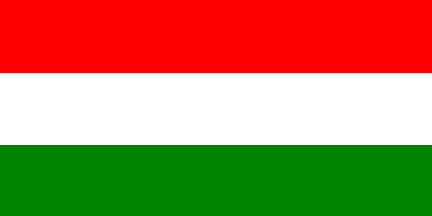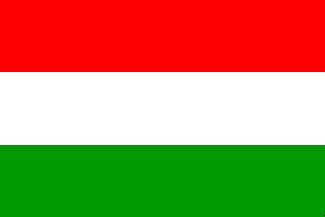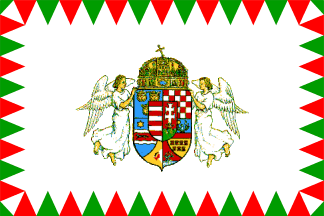
image by Antonio Martins, 24 April 1999

Last modified: 2006-02-25 by dov gutterman
Keywords: hungary | horthy | habsburg |
Links: FOTW homepage |
search |
disclaimer and copyright |
write us |
mirrors
See also:
In 1849-1867 Hungary was under direct Austrian controll.
Didn't use Hungarian symbols. In 1867-1882 used the small Coat of
Arms (on flag) and a middle Coat of Arms (small Coat of Arms in
the heart of the shield around the Dalmatian, Croatian,
Sclavonian and Transylvanian Coat of Arms). 1882-1915 used the
small Coat of Arms (on flag) and a middle Coat of Arms (small
Coat of Arms in the heart of the shield around the Dalmatian,
Croatian, Sclavonian and Transylvanian Coat of Arms and Fiume's
Coat of Arms too!!!). In 1915-1918 used the small Coat of Arms
(on flag), and the Middle Coat of Arms (small Coat of Arms in the
heart of the shield around the Dalmatian, Croatian, Sclavonian
and Transylvanian Fiume's Coat of Arms and Bosnian Coat of Arms
too - on flag. Between November 1918 and March 1919 used only the
small Coat of Arms without crown (Kossuth Coat of Arms). Between
March1919 - August 1919 didn't used Coat of Arms, but red star.
Between August 1919 and 1920 used the small Coat of Arms with or
without crown. In 1920-1946 used the small Coat of Arms with
angels or olive branches on flag. All flags were the
red-white-green tricolour (Ratio of the Hungarian tricolour is
2:1 from 1848 not 3:2).
Countries on the used Coat of Arms:
1848-1849 small Hungary
1848-1849 middle Hungary, Dalmatia, Croatia, Slavonia,
Transylvania
1849-1860 no Coat of Arms
1867-1882 small Hungary
1867-1882 middle Hungary, Dalmatia, Croatia, Slavonia,
Transylvania
1882-1915 small Hungary
1882-1915 middle Hungary, Dalmatia, Croatia, Slavonia,
Transylvania, Fiume
1915-1918 small Hungary
1915-1918 middle Hungary, Dalmatia, Croatia, Slavonia,
Transylvania, Fiume, Bosnia
1918-1919 small Hungary (without crown)
1919 red star
1919-1946 small Hungary
1938-1944 middle Hungary, Dalmatia, Croatia, Slavonia,
Transylvania, Fiume, Bosnia (only on war flags)
Istvan Molnar, 25 June 2001

image by Antonio Martins, 24 April 1999
People's Republic of Hungary 11.1918-20.03.1919 used the flag
with "Kossuth Coat of Arms" which is the Coat of Arms
without the crown.
Istvan Molnar, 9 November 2000
Hungarian Soviet Republic, 21.3.1919 - 7.1919 or Hungarian
Soviet Federative Socialist Republic (in Hungarian: Magyar
Tanácsköztársaság or Magyar Szocialista Szövetségi
Tanácsköztársaság) . The leaders of this communist state
wanted the union of Soviet Russia.
Istvan Molnar, 9 November 2000
In March 1919 Karoly give the power to the soviet of Budapest,
but in May a contrarevolutionary government was created in Arad.
I believe that in this moment the idea was that only a single
workers and peasants state should exist but only in the future.
In a short war Hungarian troops took Slovakia and created a short
lived soviet republic (one more republic instead of union with
the soviet Russia). After an war against Romania,the romanians
occupied Budapest (4 August 1919) and the soviet republic ended.
Peidl (the succesor of bela Kun) diminshed and no succesor could
be found. Then the archiduc Joseph enter into Budapest and self
proclaimed himself as a king (with the help of romanian troops).
Under allied pressure Joseph left Budapest in September. His
government collapsed on 14 November 1919 when the romanian troops
left the country. Nationalist troops took Budapest on 14 November
1919 (I believe that they came from the contrarevoltionary
government of Arad). Regency was proclaimed (1920 adopted
official national flag).
Jaume Olle, 10 November 2000
All picture found by me show the tricolour as an official flag
of the contrarrevolutionary government. The Revolutionary
Governing Soviet had resigned on 31.07.1919. The government of
Peidl (01.08.1919-06.08.1919) made an order as No. 1/1919 Order
about the name of the country: People's Republic of Hungary. I
think that this order readopted the tricolour.archiduc Joseph
self proclaimed himself as only a regent and not as a king. I
think he used the tricolour with the smaller CoA. He resigned on
23.08.1919. The rumanian troops went out of Budapest and
Tiszántúl (territory between the Danube and Tisza Rivers) on
14-16.11.1919. The Commander-in-Chief of the government of Arad
(later, 21.07.1919 on Szeged), Miklós Horthy took the oath as
the regent and his government on 15.08.1919. The
contrarevoltionary government of Szeged resigned on 19.08.1919.
On 16.11.1919 Commander-in-Chief Miklós Horthy took Budapest.
The kingdom was proclaimed (without king) on 27.02.1920 and
readopted its symbols: tricolour with a smaller CoA and the
smaller CoA
Istvan Molnar, 11 November 2000
Yesterday I was in the Nemzeti Múzeum (HNM). Here is a photo of Communist symbols in
the Parliament in 1919.
Istvan Molnar, 5 February 2006
Text over symbol: VILÁG PROLETÁRJAI EGYESÜLJETEK (Workers
of the World, unite), used by Bela Kun's Army in 1919, now in
"Orszagos Nedterdeneti Muzeum, Budapest" (State
Military History Miseum). Information provided by Jaume Olle.
Željko Heimer
Text above the symbol: CSEPELI VÖRÖS EZRED 2. zászlóalj
(The Red Regiment of Csepel 2th battalion; Csepel was a village
in 1919).
Istvan Molnar, 11 November 2000

National Flag 1919-1944
image by Željko Heimer
Hungary 1941: The ensign is a red white green horizontal
tricolor with the state arms on the white stripe. The arms are
hard to see in my copy and very complex. I think they are
per-quarter with another shield in the center that is the one
described earlier. Surrounding the shield are on the right side
an oak branch for glory, and on the left side an olive branch for
peace. It is topped by the crown of St Stephen, first Hungarian
king, the crown with the bent cross on top.
Nathan Augustine, 5 December 1995
What about inter-war and WWII Hungary, which was technically a
monarchless monarchy?
They retained the red-white-green flag with the traditional arms
topped with the Crown of St. Stephen - i.e. the same as under the
Habsburgs.
Roy Stilling, 9 April 1996
Technically, Hungary was a Regency under Admiral Horthy. So not only was it a monarchless monarchy, its head of state was an Admiral without a coastline. Hungary was forbidden by the victors of WW1 from putting a Habsburg on the throne, but the royalist constitution was restored after Horthy defeated the Communist junta of Bela Kun in 1919. When in 1921 (?) there were two attempts (March, October) by the Habsburg heir to return to Budapest there was armed resistance from Horthy’s forces, who sent the Habsburgs packing. Horthy’s official title as Regent was “His Serene Highness”, I believe, which seems an inappropriate title for so volatile an individual (although to be fair, steering a middle course between Germany and Russia in the 1930s would probably have been beyond any politician in Central Europe.)
When the Germans took over Hungary in 1944 and imposed a pro-Nazi regime, Horthy was arrested. He survived the war and lived in exile (in Portugal, I think) living long enough to see the 1956 uprising.
Anyway, in flag terms, Hungary used its red-white-green
tricolour, with the state flag having the royal coat of arms on
the white, the same arms restored after the Communist regime fell
in 1989 — even though Hungary is now a republic!
Stuart Notholt, 9 April 1996
Flaggenbuch [neo92] regarding to Hungary (pages 177 and 178):
Regent's Standard (Standarte des Reichsverwesers)

image by Željko Heimer, 5 November 2001
White flag with red and green wolf-teeth and with the
"middle" coat of arms in the middle. Ratio 2:3. Similar
flag, with flamullets is titled "Infantry
Standard 1938" - obviously the same system as used
today.
Željko Heimer, 5 November 2001
National Flag, serving as State and War Flag - Flag with CoA in the middle, basically the same as currently used.
National flag without the Coat of Arms - the tricolour.
Merchant Flag
(Handelsflagge. Dient als Heck- (National-) Flagge und G?sch der
Stormwache, sowie im Topp als Rangabzeichen des Reichsverwesers,
des Inspektors und der Kommandanten der Stormwache, sofern im
Range eines Generalmajors, des Honv?dministers, des
Oberbefelshabers des Armee, der Brigadekommandeure, der
Inspekteure der einzelen Waffengattungen.) - National flag with CoA offset to
hoist on axis dividing length in 1:2.
by Željko Heimer, 5 November 2001
Yesterday I was in the Nemzeti Múzeum (HNM) and take photo of the country flag of
the 1930s.
István Molnár, 5 February 2006
I found picture of "H"
on tricolor in the 'RUBICON' Historical Review 2001/1-2 page
19. I don't know when and where this photo was made , maybe in
1919-1920. I don't have any information about the flag.
Istvan Molnar, 26 Febuary 2001
What would you say - is that the initial H inscribed or some
other letter? Maybe AL? It surely looks like a standard that
could have been set up for Horthy, or maybe for some unit
(personal guard? maybe L there for "something Legion"?)
Just guesses.
As for where it is taken, my only guess is the Parliament
building in Budapest - but could be anything else. Regarding the
time - I wouldn't know - if you ask me it could be anytime in
20th cetury before the end of WWII.
Željko Heimer, 27 Febuary 2001
Well, this flag has a border of wolf-teeth, the ones pointing
downwards alternating red and green (I think the lighter ones are
the red ones), and the ones pointing upwards white. Within this
border is the Hungarian flag itself, red over white over
green. In the centre of the flag is a very nice, cursive
'H'. Considering the flag's position in the photograph, I'm
inclined to say that it is Regent Admiral Horthy's personal flag,
before it was altered to the one that is in Znamierowski, and
more renowned: white, with red and green wolfteeth, with the
state Coat of Arms in the centre.
Georges G. Kovari, 26 April 2001
I think that this is not a personal flag of Horthy. It seems
to be the flag adopted by Szalasi after his coup d'etat on
October 16, 1944. The letter "H" does not mean
"Horthy", it means "Hungarism", the ideology
of Szalasi's Hungarist Movement.
Ivan Marinov, 26 April 2001
would'n't it be strange for a magyar alla'mpolga'r (hungarian
citizen) to use a H like Hungarism rather than an M like
"Magyariszmus" (or whatever it may be in hungarian),
knowing the importance of using magyar szavakat (hungarian words)
in the magyar nyelv (hungarian language) ?
Olivier Touzeau, 26 April 2001
This word "Magyarizmus" is NOT possible!!!
"Hungarizmus" IS. - this was an political trend of the
extreme right before the WWII.
Istvan Molnar, 26 April 2001
Not only that. The official language of Hungary until 1844 was
Latin, not Hungarian. And in Latin Hungary is
"Hungaria".
Szalasi, a former military officer, unified all Hungarian extreme
right political parties under the name "Arrow Cross Party -
Hungarist Movement". The main hobby of Szalasi was creating
useless new words. One of such words was "hungarizmus"
(hungarism) for designating his own ideology. Szalasi claimed to
be more radical than Hitler, for this reason he used the word
"asemitism" (this is again a word created by himself)
in place of "antisemitism". Szalasi explained that
Hitler's antisemitism was merely "hate against Jews",
while his own "asemitism" meant not only hate, but
"total negation of Jews".
And an interesting fact about the personality of Szalasi. Being
the leader of the most radical Hungarian extreme right political
entity, he himself was not of Hungarian origin. His original name
was Salasyan, and he was of Armenian nationality.
Ivan Marinov, 27 April 2001
No! The photo sent by me is in the RUBICON Historical Review
2001/1-2 (page 19). On the picture you can see Miklós Horthy,
the Commander-in Chief of the Hungarian National Army in 1919. I
found another picture about the "flag" in the book
"Fortélyos félelem igazgat", 4th edition, Budapest
1980. (on the page 9)
This is a famous photo. You can see Miklós Horthy on white horse
to marche in Budapest on 16th November 1919.
Istvan Molnar, 27 April 2001
I found some photos with this flag as the flag of Commander-in
Chief of the Hungarian National Army - Horthy Miklós.
Source: História Historical Rewiev 1993/11.
Istvan Molnar, 11 January 2003